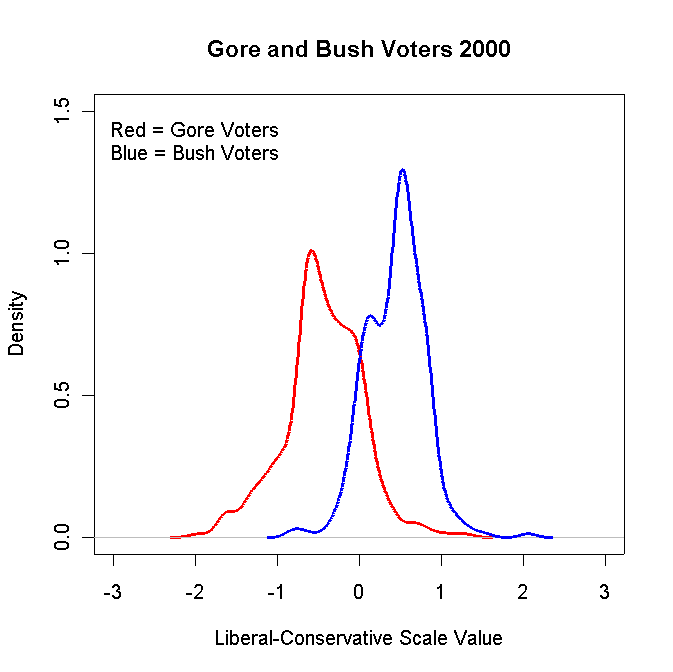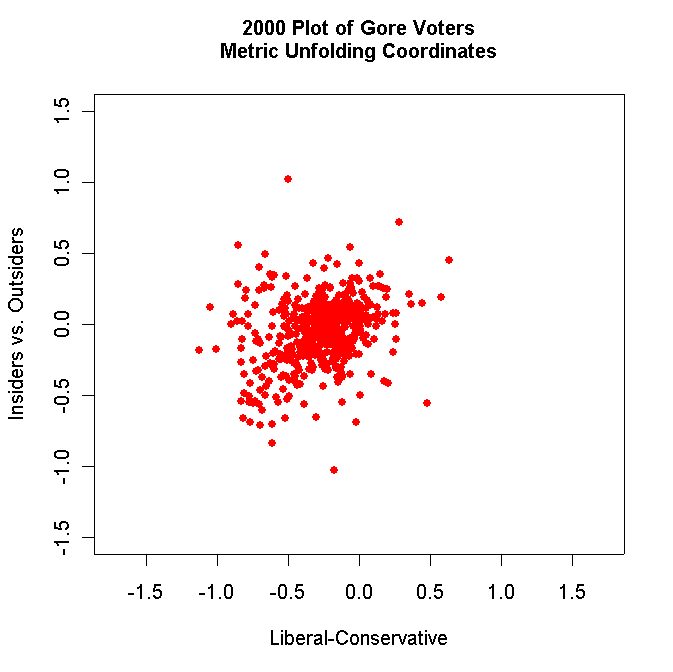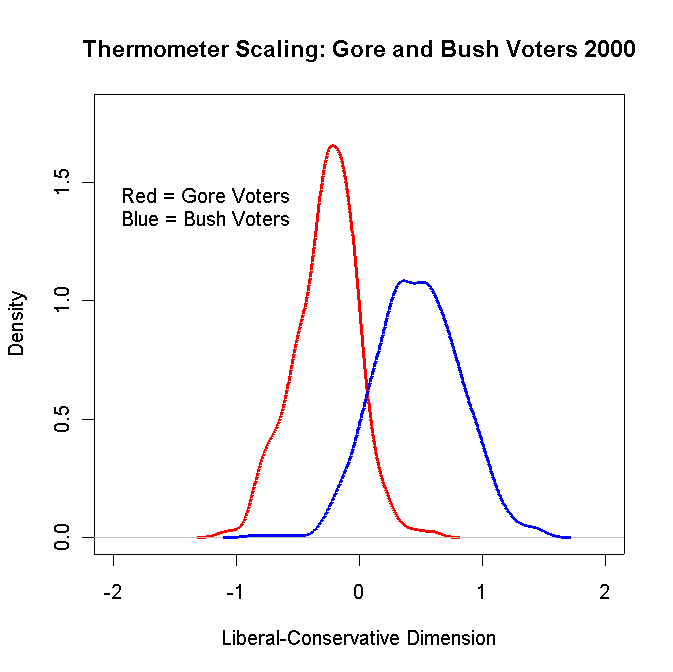and place them in the same folder on a WINTEL machine. Read the Aldrich-McKelvey scaling program page to see how to run the program.
Here are the first four lines of ELEC2000.DAT.
10787 4 8 0 0 0 2 49 1 0 65 60 30 40 70 50 998 998 40 59 75 63 65 6 1 3 6 4 0 2
21271 2 6 0 1 0 2 35 1 50 50 50 50 997 50 0 50 997 50 100 0 100 0 4 4 2 6 8 0 0
40285 2 6 0 0 0 2 63 0 70 55 55 60 65 55 55 65 50 60 70 65 65 90 6 5 5 5 5 0 1
50191 6 6 0 1 0 2 40 1 50 40 80 60 60 80 70 50 70 0 20 90 70 70 6 2 2 6 4 0 2
The variables, in order, are:
RESPONDENT ID = unique 8 digit number
PARTY ID = 0 to 6 -- 0 = Strong Democrat
1 = Weak Democrat
2 = Lean Democrat
3 = Independent
4 = Lean Republican
5 = Weak Republican
6 = Strong Republican
FAMILY INCOME = 1 to 22 - 1. A. NONE OR LESS THAN $4,999
2. B. $5,000-$9,999
3. C. $10,000-$14,999
4. D. $15,000-$24,999
5. E. $25,000-$34,999
6. F. $35,000-$49,999
7. G. $50,000-$64,999
8. H. $65,000-$74,999
9. J. $75,000-$84,999
10. K. $85,000-$94,999
11. M. $95,000-$104,999
12. N. $105,000-$114,999
13. P. $115,000-$124,999
14. Q. $125,000-$134,999
15. R. $135,000-$144,999
16. S. $145,000-$154,999
17. T. $155,000-$164,999
18. U. $165,000-$174,999
19. V. $175,000-$184,999
20. W. $185,000-$194,999
21. X. $195,000-$199,999
22. Y. $200,000 and over
RACE = 0 White, 1 Black
SEX = 0 Man, 1 Woman
SOUTH = 0 North, 1 South
EDUCATION = 1 High School or less, 2 Some College, 3 College
AGE = In Years
MARRIED = 0 Single, 1 Married
FEELING THERMOMETERS (0 TO 100)
= CLINTON
= GORE
= BUSH
= BUCHANAN
= NADER
= MCCAIN
= BRADLEY
= LIEBERMAN
= CHENEY
= HILLARY CLINTON
= DEMOCRATIC PARTY
= REPUBLICAN PARTY
= REFORM PARTY
= PARTIES IN GENERAL
LIBERAL-CONSERVATIVE SCALE (1=EXTREMELY LIBERAL, 2=LIBERAL, 3=SLIGHTLY LIBERAL,
4=MODERATE; MIDDLE OF THE ROAD, 5=SLIGHTLY CONSERVATIVE,
6=CONSERVATIVE, 7=EXTREMELY CONSERVATIVE)
= SELF-PLACEMENT
= CLINTON
= GORE
= BUSH
= BUCHANAN
PRE-POST INTERVIEW = 1 IF PRE-ELECTION INTERVIEW ONLY
VOTE CHOICE = 0 NON-VOTER
= 1 GORE
= 2 BUSH
= 3 3RD PARTY
Run the Aldrich-McKelvey scaling procedure on the 2000 election
Liberal-Conservative 7-Point scale. Save the coordinate output files. -
Use Epsilon to merge the PARTY ID,
FAMILY INCOME, RACE, SEX, and VOTE CHOICE
variables from ELEC2000.DAT into the coordinate
output file. For example, here are the first few lines of the coordinate
output file:
LINE # CASE # R POS ALPHA BETA SCALED POS RSQ
1 10787 6.0 -1.0037 0.2868 0.7169 0.6136 0.7834
4 50191 6.0 -1.1883 0.3395 0.8488 0.7278 0.8531
5 70894 5.0 -1.0960 0.2923 0.3653 0.8212 0.9062
6 80889 4.0 -1.5136 0.3187 -0.2390 0.8597 0.9272
7 90892 3.0 -1.4170 0.3149 -0.4723 0.9675 0.9836
and here are the first few lines of the coordinate output file after the
variables are merged in (using a macro that I wrote):
1 4 8 0 0 2 10787 6.0 -1.0037 0.2868 0.7169 0.6136 0.7834
4 6 6 0 1 2 50191 6.0 -1.1883 0.3395 0.8488 0.7278 0.8531
5 5 12 0 0 0 70894 5.0 -1.0960 0.2923 0.3653 0.8212 0.9062
6 0 7 0 1 1 80889 4.0 -1.5136 0.3187 -0.2390 0.8597 0.9272
7 0 11 0 1 1 90892 3.0 -1.4170 0.3149 -0.4723 0.9675 0.9836
Turn in the Epsilon macro you write that inserts
the above variables into the coordinate file. In the macro, use a
split screen and place the coordinate file in the top screen and
ELEC2000.DAT in the bottom screen.Simplify the coordinate file by deleting all the columns except for those you inserted, BETA (you will need that for graphing), and the Scaled Position. If you have done everything correctly the first few lines of your file should look like this:
4 8 0 0 2 0.2868 0.7169
6 6 0 1 2 0.3395 0.8488
5 12 0 0 0 0.2923 0.3653
0 7 0 1 1 0.3187 -0.2390
0 11 0 1 1 0.3149 -0.4723
0 6 0 1 1 0.3681 -1.0123
5 7 0 1 1 0.1850 0.0000
etc.
etc.
etc.
Read the above file into R and
make smoothed histograms of the scaled positions of the respondents
by party ID. Replicate the graphs you did for
question 2.c of homework 6. Use positive
BETA respondents only in this graph and all the graphs below.Make smoothed histograms of the scaled positions of the respondents by their presidential vote (Bush and Gore). Turn in the graph and the R code you used to make your graph. It should look something like this:

Make smoothed histograms of the scaled positions by Race. Turn in the graph and the R code you used to make your graph.
Make smoothed histograms of the scaled positions by Sex. Turn in the graph and the R code you used to make your graph.
Make smoothed histograms of the scaled positions by Low and High Income. Pick a reasonable breakpoint -- for example, $35,000 and down versus $35,000 and up. Turn in the graph and the R code you used to make your graph. Also, write a short paragraph justifying your breakpoint!!!
-
Run MLSMU6. It will produce an output
file called FORT.22. The first 20 lines look
like this:
CLINTON -0.7879 -0.0317 153.1404 0.7198 1477.0000
GORE -0.7133 -0.1701 112.1776 0.7061 1468.0000
BUSH 0.8234 -0.2492 149.4325 0.5889 1458.0000
BUCHANAN 0.4576 1.0536 178.0645 0.3114 1246.0000
NADER -0.2737 0.7599 174.6307 0.2645 1094.0000
MCCAIN 0.2850 -0.6498 122.5794 0.3691 1182.0000
BRADLEY -0.0780 -0.7509 106.1498 0.3689 1088.0000
LIEBERMAN -0.3428 -0.6394 107.1314 0.4758 1096.0000
CHENEY 0.7002 -0.4687 107.9753 0.5099 1147.0000
HILLARY -0.8617 0.0625 203.7540 0.6459 1466.0000
DEMPARTY -0.6788 -0.1713 112.8208 0.6861 1453.0000
REPUBPARTY 0.8235 -0.3286 142.8395 0.5546 1447.0000
REFORMPTY 0.1644 1.0398 132.9094 0.3140 1128.0000
PARTIES 0.1949 -0.7946 158.0865 0.2290 1413.0000
1 0.3666 -0.0534 1.2943 0.3584 12.0000
2 -0.2740 0.6767 2.5447 0.5465 12.0000
4 0.0094 0.0645 0.8008 0.0000 14.0000
5 0.5073 -0.0010 1.3888 0.6249 14.0000
7 0.2719 0.0294 0.3600 0.5458 14.0000
8 -0.6582 -0.2931 1.8168 0.7683 14.0000
etc etc etc
etc etc etc
Use R to plot the
14 stimuli in two dimensions. This plot should be very similar to the one
you did for question 2 of homework 5
and question 3 of homework 7.Use Epsilon to insert the VOTE CHOICE variable into FORT.22 (strip off the candidate coordinates first). Turn in the Epsilon macro you used to do the insertion and the first 20 lines of the file.
Use R to make two-dimensional plots of the Voters, Non-Voters, Gore Voters only, and Bush Voters only. For example, your Gore Voter plot should look something like this:

Label each plot appropriately and use solid dots to plot the respondents. Turn in all these plots.
Use R to make smoothed histograms -- using the first dimension from the thermometer scaling -- of the Voters and Non-Voters only, and the Gore and Bush Voters only. For example, your Gore and Bush Voter plot should look something like this:

Turn in the R code and the plots.
The Control Card file -- QUADSTRT.DAT -- looks like this:
HOU106KH.ORD
QUADRATIC-NORMAL MULTIDIMENSIONAL UNFOLDING
1 1209 10 36 1
(36A1,3600I1)
(I5,1X,36A1,2I5,50F8.3)
(I5,1X,36A1,2I5,F8.3,F12.3,50F8.3)
The first line has the name of the data file. The second line, in order,
is the number of dimensions to estimate, the number of roll calls, the
number of iterations for the program to run, the number of characters on
the header of each line of the input file, and the last number tells the
program to put that legislator on the left (i.e., less than zero -- in this
instance, former President Clinton).The legislator coordinates are in the output file QUAD0048.DAT. The first ten lines look like this:
1 1069990999 0USA 100 CLINTON 80 15 0.842 -33.626 0.702 -0.993 2.381 0.184
2 1061509041 1ALABAMA 20001CALLAHAN 771 71 0.916 -156.782 0.830 0.516 0.877 0.024
3 1062930041 2ALABAMA 20001EVERETT 762 72 0.914 -151.022 0.834 0.821 1.111 0.025
4 1062970041 3ALABAMA 20001RILEY 765 83 0.902 -227.007 0.765 0.792 1.667 0.047
5 1062970141 4ALABAMA 20001ADERHOLT 750 117 0.865 -321.978 0.690 0.765 2.381 0.049
6 1062910041 5ALABAMA 10001CRAMER 725 136 0.842 -296.563 0.709 -0.080 0.862 0.015
7 1062930141 6ALABAMA 20001BACHUS 776 87 0.899 -185.823 0.806 0.510 1.000 0.025
8 1062930241 7ALABAMA 10001HILLIARD 679 166 0.804 -277.545 0.720 -0.910 2.083 0.044
9 1061406681 1ALASKA 20001YOUNG DON 670 82 0.891 -171.757 0.796 0.530 1.064 0.029
10 1062950061 1ARIZONA 20001SALMON 721 85 0.895 -212.400 0.768 0.954 1.786 0.036
etc etc etc
etc etc etc
The estimated coordinate is the sixth column after the legislator's name (President
Clinton's coordinate is -0.993).-
Use R to make a smoothed histogram
of the Republicans and Democrats in the 106th House using the estimated
coordinates above. Turn in the R code and the plot.
Be sure to label everything appropriately.
Use Epsilon to change the number of dimensions to "2" in QUADSTRT.DAT and run the program again (be sure to save QUAD0048.DAT from the one dimensional run as it will be overwritten). The two-dimensional coordinate file looks like this:
1 1069990999 0USA 100 CLINTON 83 12 0.874 -30.335 0.727 -0.657 -0.188 2.273 0.157 0.352
2 1061509041 1ALABAMA 20001CALLAHAN 784 58 0.931 -143.551 0.843 0.178 0.075 0.562 0.014 0.043
3 1062930041 2ALABAMA 20001EVERETT 789 45 0.946 -104.665 0.882 0.279 0.402 0.617 0.019 0.054
4 1062970041 3ALABAMA 20001RILEY 780 68 0.920 -158.286 0.830 0.265 0.521 0.820 0.021 0.046
5 1062970141 4ALABAMA 20001ADERHOLT 770 97 0.888 -205.973 0.789 0.226 0.707 0.962 0.014 0.045
6 1062910041 5ALABAMA 10001CRAMER 753 108 0.875 -242.840 0.754 -0.089 0.261 0.549 0.008 0.020
7 1062930141 6ALABAMA 20001BACHUS 785 78 0.910 -178.645 0.813 0.185 0.074 0.658 0.013 0.040
8 1062930241 7ALABAMA 10001HILLIARD 748 97 0.885 -234.053 0.758 -0.681 0.732 1.563 0.027 0.061
9 1061406681 1ALASKA 20001YOUNG DON 679 73 0.903 -163.845 0.804 0.180 0.082 0.685 0.018 0.048
10 1062950061 1ARIZONA 20001SALMON 722 84 0.896 -204.598 0.776 0.506 -0.182 1.389 0.026 0.085
etc etc etc
etc etc etc
The estimated two dimensional coordinates are the sixth and seventh columns after
the legislator's name (President Clinton's coordinates are -0.657 -0.188).
Use R to plot the legislators in two dimensions. Use
"D" for Non-Southern Democrats, "S" for Southern Democrats, "R" for Republicans, and
"P" for President Clinton. This graph should be in the same format as the one
you did for question 3.e of Homework 6. Turn in the
R code and the plot. Be sure to label everything
appropriately.Use R to make a smoothed histogram of the Republicans and Democrats in the 106th House using the estimated first dimension coordinates above. Turn in the R code and the plot. Be sure to label everything appropriately.
Compare the smoothed histograms of the Gore and Bush Voters that you did above in 1.c and 2.d with the smoothed histograms you did for 3.a and 3.c. What is your interpretation of these three graphs collectively? Limit your answer to no more than two paragraphs.